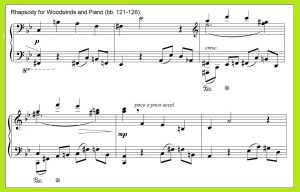Pieces of Eight
Most musicians are familiar with the seven-tone diatonic set, which determines the pitches for a major scale or a natural minor scale. But how about the eight-tone octatonic set, which often appears in the music of late Romantic composers like Rimsky-Korsakov?

The spacing in an octatonic set alternates between whole steps and half steps. An octatonic set can naturally arise in tonal music when each tone of a diminished-seventh chord is embellished by its chromatic lower neighbor. Something like that happens in bars 77-78 of my Prelude No. 3 (although only seven of the eight tones are represented in this passage, since D-sharp is not embellished by D-natural or C-double-sharp).

A more extended example occurs in the piano part of this passage from my Rhapsody for Woodwinds and Piano:

The woodwind parts in this passage mostly adhere to the same octatonic set, except not perfectly, because in some cases I embellish the diminished-seventh with chromatic upper neighbors instead of chromatic lower neighbors.
You may have noticed that these two passages not only both use an octatonic set, but they also happen to use the same octatonic set? What are the chances of that? Hmmm…well, that depends on just how many distinct octatonic sets there are, a question which I shall leave as an exercise for the mathematically inclined reader. 🙂
By the way, at the time I composed these two works, I do not believe I had ever heard the term “octatonic.” The latter is not merely a theoretical construct, but something that arises naturally in tonal composition.
In my dissertation, which I wrote years later, I point to examples in Rachmaninoff of octatonic and of an equally exotic variant I call “quasi-octatonic” (where one of the octatonic pitches is displaced by a half step). Some good examples of the latter can also be found in my own Piano Sonata No. 4.
You can hear the exotic sound of the octatonic in the aforementioned passage from the Rhapsody, beginning around 6:24 in this video:

